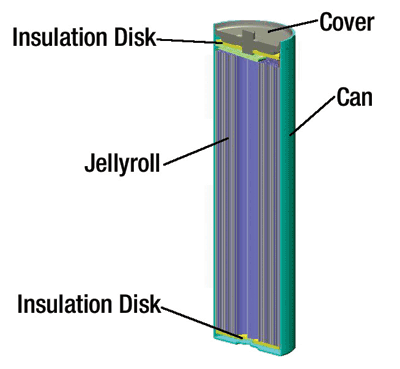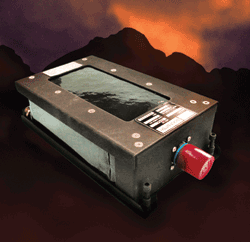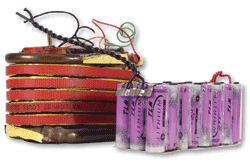High-energy Li batteries offer big bang for buck
Lithium metal oxide chemistry replaces decades-old technology to reduce costs and increase reliability of mil/aero systems
BY SOL JACOBS
Tadiran Batteries, Port Washington, NY
www.tadiranbat.com
Recognizing that battery technology limitations would ultimately lead to bottlenecks in new product development, the U.S. DoD recently identified a critical need for a new generation of high-power, long-life batteries. The search for the ideal power management solution has led scientists at Tadiran to develop the TLM series, a family of high-power lithium metal oxide batteries that are currently in use in a variety of military and aerospace applications. This new generation of high-power lithium batteries is generating significant interest among mil/aero design engineers based on performance attributes such as exceptionally long shelf life, high-rate power, instantaneous activation, and high survivability in extreme environmental conditions.

Internal view of lithium metal oxide battery
While mil/aero design engineers tend to prefer tried-and-true technologies to avoid the costs and delays associated with attaining Mil-spec approvals, in light of the DoD’s directive to employ more modern battery technologies, design engineers need to expand their knowledge and understanding about available battery technologies, including:
• Reserve and thermal batteries.• Silver-zinc batteries.• Spin-activated batteries.• Rechargeable batteries.• LiSO2 batteries.• Lithium metal oxide batteries.

Fig. 1. Mil/aero batteries must provide high-rate power, instantaneous activation, and high survivability in extreme environmental conditions
The following is a brief overview of the battery chemistries commonly used in mil/aero applications:
Reserve and thermal batteries
Reserve batteries encompass a broad range of chemistries, including lead-acid, silver-zinc, and lithium thionyl chloride. With all reserve batteries, the electrolyte is stored separately from other active ingredients, remaining inert until a pyrotechnic device is used to initiate a chemical reaction.
The most popular type of reserve battery is the thermal battery, which uses a metallic salt electrolyte that is inert and nonconducting while in a solid state and at ambient temperatures. The cell is activated by a squib that delivers a pyrotechnic charge that causes the electrolyte to become continually molten at temperatures ranging from 400° to 700°C, allowing the cell to achieve optimum conductivity. Once activated, the thermal battery delivers high-rate power for a relatively brief time, delivering continuous current that ranges from a few watts to several kilowatts depending upon the battery’s size and chemistry.
Thermal batteries offer certain advantages, including ruggedness, safety, reliability, and long shelf life. However, this type of cell also has inherent limitations, as reserve/thermal batteries cannot be tested without the battery being fully depleted, and battery activation is delayed until the chemical reaction occurs.
Another major drawback is that thermal batteries must be comparatively bulky, with layers of insulation required to retain heat so the activated electrolyte can remain molten as well as to protect surrounding components from heat-related damage. Reserve batteries are exclusively designed for single-use applications.
Silver zinc batteries
Silver zinc batteries are more complex in design and expensive to manufacture, requiring a gas generator, tubular electrolyte reservoir, manifold, battery block, vent, and heating system. As a result, silver zinc batteries require longer production lead times, and have performance limitations due to their low energy density (260 Wh/L).
Spin-activated batteries
Commonly used for fuses and certain marine applications, spin-activated batteries store electrolyte inside an ampoule or bladder that is cut open when the projectile is fired, and the centrifugal force of the spinning shell distributes the electrolyte throughout the cell stack. Spin-activated batteries are exclusively designed for single-use applications.
Spin-activated batteries manufactured using lithium thionyl chloride chemistry are currently being used to power minelets and communication jammers propelled by artillery shells equipped with parachutes to ensure a soft landing.
Spin-activated batteries have also been deployed in Multi-Option Fuses for Artillery (MOFA) applications, including 105- and 155-mm bursting artillery projectiles. Seeking a standardized solution, the U.S. DoD recently chose to power the latest generation of MOFAs with lithium oxhalide batteries instead of lead-acid or thermal batteries. Had these MOFA devices been powered by high-power lithium metal oxide batteries instead of lithium oxhalide chemistry, significant performance advantages could have been realized, including seven times greater capacity (200 mAh vs. 30 mAh), over ten times greater current (3.5 A vs. 325 mA), more stable voltage, and faster activation (instantaneous vs. a 100-ms delay).
Lithium sulfer dioxide
Lithium sulfur dioxide cells (LiSO2 ) are used almost exclusively in military/aerospace applications, primarily involving mobile communication equipment and manpacks. These cells offer limited service life and deliver less than half the energy density of lithium thionyl chloride batteries. LiSO2 cells perform best in applications that require continuous high-rate power for several hours.
Rechargeable military batteries
While the military relies mostly on primary batteries due to mobility needs, rechargeable batteries are also being deployed in various battlefield applications such as man-pack radios and sensors. Drawbacks to the use of rechargeable cells include the need for access to electricity and suitable time for recharging.
Rechargeable battery technology has evolved considerably in recent years. Whereas the earliest sealed lead-acid rechargeable cells suffered from relatively short service life, reduced capacity, and excess weight, newer generations of NiCd, NiMH and lithium ion cells offer increased capacity, reduced weight, and longer operating life. Rechargeable battery technology continues to progress with the introduction of rechargeables suitable for low-temperature applications, and LiNiCoAl, LiFePO, and LiNiMnCo chemistries that offer higher energy density and improved safety.
High-power lithium metal oxide batteries
Recently, Tadiran introduced the TLM military-grade high-power lithium metal oxide batteries that use COTS technology to deliver high-current pulses and high-rate energy, with up to 20 years of storage life due to an annual self-discharge rate of less than 1% per year at room temperature. These cells are currently available in three standard cylindrical configurations (AA-size, CR-2 size, and 20-mm length), and a AAA-size (10-mm) cell will soon be available. The high-power batteries can also be easily configured into battery packs to meet customer-specific requirements, with very fast turnaround for both product design and manufacturing cycles, and significant cost savings since they use standard COTS components.
The lithium metal oxide batteries deliver up to 2 Wh of energy, and feature a nominal voltage of 4 V, with a discharge capacity of 135 to 500 mAh, capable of handling 5-A continuous pulses and 15-A max high-current pulses. These batteries are constructed with a carbon-based anode, multi-metal-oxide cathode, organic electrolyte, and shut-down separator for enhanced safety. The batteries also feature extremely low self-discharge, a wide operating temperature range (40 to 85C.), and comply with MIL-STD 810G specs for vibration, shock, temperature shock, salt fog, altitude, acceleration (50,000 gn), and spinning (30,000 rpm). These batteries also conform to UN 1642 and IEC 60086 standards for crush, impact, nail penetration, heat, overcharge, and short circuit, and can be shipped as nonhazardous goods.
High-power lithium metal oxide cells do not generate high internal temperatures associated with thermal batteries, thus eliminating the need for layers of thermal insulation, resulting in significant size, weight, and cost reductions, especially when compared to silver zinc batteries that require squibs, gas generators, and external heating elements.

Fig. 2. Twenty-four AA-size lithium batteries are smaller than silver-zinc pack.
Unlike thermal/reserve and spin-activated batteries, high-power lithium metal oxide cells permit instantaneous activation without the need for squibs or gas generators. These batteries can also be periodically tested to ensure system readiness, thus reducing the number of “duds” in missile guidance systems. Power from these cells can be drawn intermittently, so they are not restricted to single-use applications. ■
Advertisement
Learn more about Tadiran





